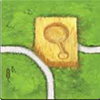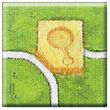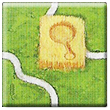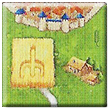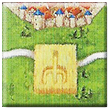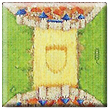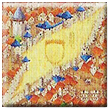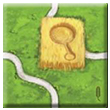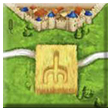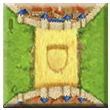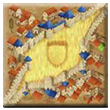Crop Circles
 |
You are reading the rules for this tile design. |  |
 | Read the following rules if your tiles look like this. |
| If your tiles have a different design, then choose a game from Spin-offs. |  |
Mysterious shapes appear in the fields of Carcassonne, holding a strange power over the knights, thieves, and farmers of the realm.
General info and comments
Crop Circles (Mini #7) was released by HiG for the second edition, known as C2 for short, in 2017, bundled as part of Big Box 6. A third edition, known as C3 for short, was released in 2021 including more detailed graphics, cities with clipped buildings and some minor wording changes. The C3 version of this expansion is only available as part of Big Box 7.
This expansion was originally released for the first edition, known as C1 for short, in 2012.
Contents
- 6 landscape tiles with crop circles [1]
Rules
Preparation
Shuffle the new landscape tiles with those of the basic game and stack them normally.
Gameplay
When you draw a tile with a crop circle, perform a standard turn, following the normal order of 1. Place a Tile, 2. Place a Meeple, and 3. Score a Feature. Then, perform the new action: 4. Crop Circle Action.
Note: The crop circles separate roads and fields. Meeples cannot occupy crop circles.
4. Crop Circle Action
After you place a tile with a crop circle on it, you must choose one of the following actions:
- A) Based on the crop circle, you may [2] deploy a meeple from your supply next to one your meeples already on a tile. [3]
- OR
- B) Based on the crop circle, you must remove one of your meeples from a feature and return it to your supply.
Then, all players (starting with the player to your left and proceeding clockwise) must perform the action you chose, and then you perform that action.
Additional rules
- The type of meeples that are added or removed is determined by the crop circle you placed:
- If A was chosen, you may only place the meeple in a feature where at least one of your indicated meeples is already present (farmer to farmer, highwayman to highwayman, knight to knight). [4]
- If you do not have any meeples of the indicated type in play, but you placed the tile, you must still choose A or B.
- If you do not have any meeples of the indicated type in play [5], you do not perform the chosen action.
- Once all players have performed the chosen action, play resumes, starting with the player on your left. [6]
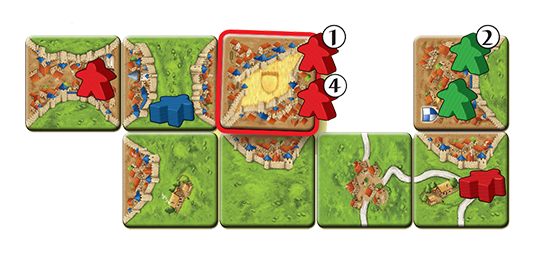
- You place a tile with the Shield crop circle and place one of your meeples on it as a knight. You choose action A. Each player may place a knight next to one of their knights. [7]
- The green player adds another knight.
- The blue player has no knights in play, and does nothing.
- You place another knight next to the one you placed earlier in the turn. You could not have chosen the city on the upper-left side of the tile, because you did not already have a knight there. (You could also have deployed the knight next to your knight in the upper left corner). [8]
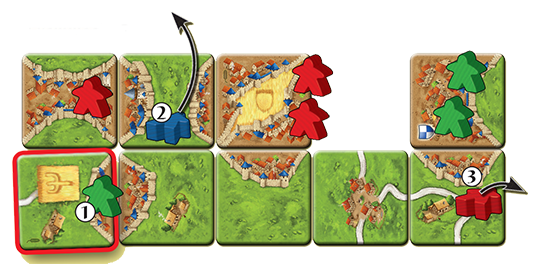
- The green player places a tile with the Rake crop circle, and places a meeple on it as a knight. This completes the city, awarding green with 4 points. Then, the green player chooses action B.
- The blue player removes a farmer.
- You remove a farmer.
- The green player has no farmers, and does nothing.
Tile distribution
C3 Edition
C2 Edition
Footnotes
For Icons explanation and licensing please visit Icons page.
- ↑
 Crop fields (the yellow areas) are distinct features and thus separate road segments and field segments. (1/2013)
Crop fields (the yellow areas) are distinct features and thus separate road segments and field segments. (1/2013)
- ↑
 The ZMG rules consider that placing the meeple is mandatory unless not possible for a player. This discrepancy can be the result of a mistranslation.
The ZMG rules consider that placing the meeple is mandatory unless not possible for a player. This discrepancy can be the result of a mistranslation.
- ↑
 The ZMG rules indicate that you add the meeple to "a feature where you already have a meeple", that is, the meeple can be placed on any tile of a feature with another meeple belonging to the player. This discrepancy can be the result of a mistranslation.
The ZMG rules indicate that you add the meeple to "a feature where you already have a meeple", that is, the meeple can be placed on any tile of a feature with another meeple belonging to the player. This discrepancy can be the result of a mistranslation.
This discrepancy has clear implications, for example, in the interactions with Exp. 3 - The Princess and the Dragon and Exp. 4 - The Tower, since the ZMG rules allow players to place additional meeples on a different tile than the meeple previously present in a feature. This would allow players to increment their odds against the dragon or the tower. - ↑
 Any meeple that can be put on a road is considered a highwayman. Any meeple that can be put in a city is considered to be a knight.
Any meeple that can be put on a road is considered a highwayman. Any meeple that can be put in a city is considered to be a knight.
- ↑
 The ZMG rules added the condition "and did not place the tile" here, that is unnecessary and may be misleading as the sentence can be interpreted as if the active player is forced to execute the action always, even if he or she does not have any meeples of the indicated type in play.
The ZMG rules added the condition "and did not place the tile" here, that is unnecessary and may be misleading as the sentence can be interpreted as if the active player is forced to execute the action always, even if he or she does not have any meeples of the indicated type in play.
- ↑
 After the crop circle action, the active player should continue with any actions pending as part of their turn, such as removing a knight from a sieged city through a monastery (see Besiegers - Cathars - Siege) or performing the second part of a double turn (see Exp. 2 - Traders and Builders). After all pending actions are performed, the next player's turn can proceed.
After the crop circle action, the active player should continue with any actions pending as part of their turn, such as removing a knight from a sieged city through a monastery (see Besiegers - Cathars - Siege) or performing the second part of a double turn (see Exp. 2 - Traders and Builders). After all pending actions are performed, the next player's turn can proceed.
- ↑
 The ZMG rules omitted this last sentence.
The ZMG rules omitted this last sentence.
- ↑
 The ZMG rules omitted this clarification.
The ZMG rules omitted this clarification.

